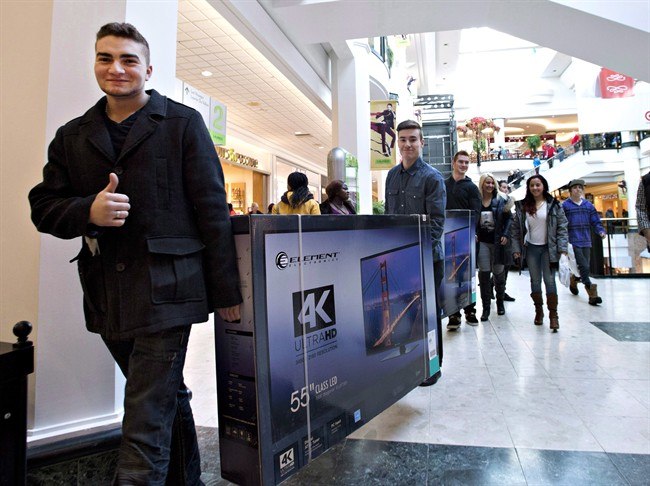By Terry Pedwell, The Canadian Press
GATINEAU, Que. – Cable and satellite service providers will soon have to offer consumers an “entry-level” television service, at a cost of no more than $25 a month, a decision that the country’s broadcast regulator acknowledges will cost some people their jobs.
They’ll also have to give customers a choice, on top of the basic package, of either paying for additional channels individually or in smaller bundles, says the Canadian Radio-television and Telecommunications Commission.
The Harper government welcomed the move — something it has been pushing for in the run-up to the fall federal election — but critics including Friends of Canadian Broadcasting warn it’ll hurt the economy and the country’s TV industry as a whole.
The new, trimmed-down basic packages must include local channels in each service area, as well as channels currently on the CRTC’s mandatory distribution list such as public interest, educational and legislature channels where they’re available.
U.S.-based broadcasters that are currently free over the air in most major Canadian markets near the border — so-called 4-plus-1 channels — will also be included.
It’s the first time television service pricing has been regulated in Canada since 1999 and makes it the only jurisdiction in the industrialized world to require that TV distribution companies offer a basic selection of channels.
The national broadcast regulator said it expects service providers to offer trimmed-down basic packages by March 2016.
TV viewers will then be able to supplement the so-called “skinny basic” package with either individual channels available through a pick-and-pay model, or what it calls small, “reasonably-priced” bundled channel packages, the CRTC ruled.
But service providers will have until the end of next year to offer both a la carte channels and theme packages.
Customers who are happy with their current TV offerings won’t have to switch.
“Canadians will have the choice of keeping their current television services without making any changes, if these continue to meet their needs and budgets,” the CRTC said in a statement.
CRTC chairman Jean-Pierre Blais said technology has changed Canada’s TV industry to the point that viewers are taking it upon themselves to choose what they want to watch, when they want to watch it.
“Viewers are in control,” Blais said.
“Today’s decision is not about making choices for Canadians,” he said.
“Rather, it’s about setting out a road map to give all Canadians the freedom to choose the television content that meets their unique needs, budgets and realities.”
Still, Blais acknowledged that the changes will likely cost some people their jobs as already struggling TV channels lose revenues and go off the air.
That goes against government pledges that any plan to offer “pick-and-pay” TV services should not affect jobs, said Ian Morrison, a spokesman for the group Friends of Canadian Broadcasting.
“This is reckless,” said Morrison.
“We don’t think (the CRTC) passed the test that the government gave them about protecting Canadian jobs.”
Heritage Minister Shelly Glover didn’t acknowledge the potential for job losses in a statement reacting to the decision.
Instead, she called on service providers to move to a pick-and-pay system sooner than the Dec. 2016 deadline imposed by the regulator.
“While we understand that the CRTC feels the industry needs time to adjust to the new rules, we call on all industry players to deliver the choice to Canadians that they deserve in a timely manner,” said Glover.
Under the new system, service providers will not have to offer free audio services, such as local radio stations, although they can include them if they want.
The $25-a-month price won’t include the cost of renting or buying a cable or satellite set-top box. Nor will it include taxes. But service providers could offer an even lower price.
Rogers Inc. flirted with entry-level pricing when it test-marketed a digital basic package in the London, Ont., area from Nov. 2011 until Feb. 2012, at a cost of $19.99 a month.
Rogers reacted positively to the CRTC decision Thursday, saying it was pleased the regulator agreed to include American channels in the basic service mix.
The move “is a real win for Canadians,” added Ann Mainville-Neeson, the vice-president of broadcasting policy and regulatory affairs at Telus.
“The decision explicitly prohibits anti-consumer contract terms which have historically limited our ability to enhance consumer choice and flexibility,” she said.
Bell Media said it would not comment on the decision.
While relief may be in sight for Canadians fed up with paying for TV programming they never watch, the new rules mean subscribers will still have to pay for some channels they don’t necessarily want, resulting in a basic package that will cost more than what many viewers were hoping for, said advocacy group OpenMedia.
To make sure the big networks don’t shut out independent broadcasters from basic services, the CRTC also introduced a code of conduct for the industry Thursday.
